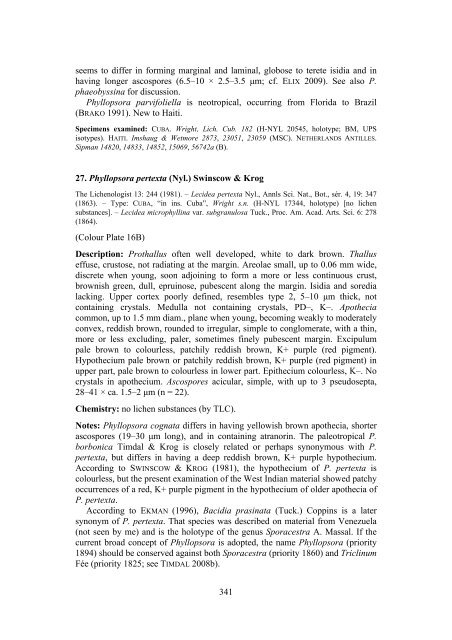A Lichenological Legacy – Festschrift Thomas H
A Lichenological Legacy – Festschrift Thomas H
A Lichenological Legacy – Festschrift Thomas H
You also want an ePaper? Increase the reach of your titles
YUMPU automatically turns print PDFs into web optimized ePapers that Google loves.
seems to differ in forming marginal and laminal, globose to terete isidia and in<br />
having longer ascospores (6.5<strong>–</strong>10 × 2.5<strong>–</strong>3.5 μm; cf. ELIX 2009). See also P.<br />
phaeobyssina for discussion.<br />
Phyllopsora parvifoliella is neotropical, occurring from Florida to Brazil<br />
(BRAKO 1991). New to Haiti.<br />
Specimens examined: CUBA. Wright, Lich. Cub. 182 (H-NYL 20545, holotype; BM, UPS<br />
isotypes). HAITI. Imshaug & Wetmore 2873, 23051, 23059 (MSC). NETHERLANDS ANTILLES.<br />
Sipman 14820, 14833, 14852, 15069, 56742a (B).<br />
27. Phyllopsora pertexta (Nyl.) Swinscow & Krog<br />
The Lichenologist 13: 244 (1981). <strong>–</strong> Lecidea pertexta Nyl., Annls Sci. Nat., Bot., sér. 4, 19: 347<br />
(1863). <strong>–</strong> Type: CUBA, “in ins. Cuba”, Wright s.n. (H-NYL 17344, holotype) [no lichen<br />
substances]. <strong>–</strong> Lecidea microphyllina var. subgranulosa Tuck., Proc. Am. Acad. Arts. Sci. 6: 278<br />
(1864).<br />
(Colour Plate 16B)<br />
Description: Prothallus often well developed, white to dark brown. Thallus<br />
effuse, crustose, not radiating at the margin. Areolae small, up to 0.06 mm wide,<br />
discrete when young, soon adjoining to form a more or less continuous crust,<br />
brownish green, dull, epruinose, pubescent along the margin. Isidia and soredia<br />
lacking. Upper cortex poorly defined, resembles type 2, 5<strong>–</strong>10 μm thick, not<br />
containing crystals. Medulla not containing crystals, PD<strong>–</strong>, K<strong>–</strong>. Apothecia<br />
common, up to 1.5 mm diam., plane when young, becoming weakly to moderately<br />
convex, reddish brown, rounded to irregular, simple to conglomerate, with a thin,<br />
more or less excluding, paler, sometimes finely pubescent margin. Excipulum<br />
pale brown to colourless, patchily reddish brown, K+ purple (red pigment).<br />
Hypothecium pale brown or patchily reddish brown, K+ purple (red pigment) in<br />
upper part, pale brown to colourless in lower part. Epithecium colourless, K<strong>–</strong>. No<br />
crystals in apothecium. Ascospores acicular, simple, with up to 3 pseudosepta,<br />
28<strong>–</strong>41 × ca. 1.5<strong>–</strong>2 μm (n = 22).<br />
Chemistry: no lichen substances (by TLC).<br />
Notes: Phyllopsora cognata differs in having yellowish brown apothecia, shorter<br />
ascospores (19<strong>–</strong>30 μm long), and in containing atranorin. The paleotropical P.<br />
borbonica Timdal & Krog is closely related or perhaps synonymous with P.<br />
pertexta, but differs in having a deep reddish brown, K+ purple hypothecium.<br />
According to SWINSCOW & KROG (1981), the hypothecium of P. pertexta is<br />
colourless, but the present examination of the West Indian material showed patchy<br />
occurrences of a red, K+ purple pigment in the hypothecium of older apothecia of<br />
P. pertexta.<br />
According to EKMAN (1996), Bacidia prasinata (Tuck.) Coppins is a later<br />
synonym of P. pertexta. That species was described on material from Venezuela<br />
(not seen by me) and is the holotype of the genus Sporacestra A. Massal. If the<br />
current broad concept of Phyllopsora is adopted, the name Phyllopsora (priority<br />
1894) should be conserved against both Sporacestra (priority 1860) and Triclinum<br />
Fée (priority 1825; see TIMDAL 2008b).<br />
341<br />
eschweizerbart_xxx

















